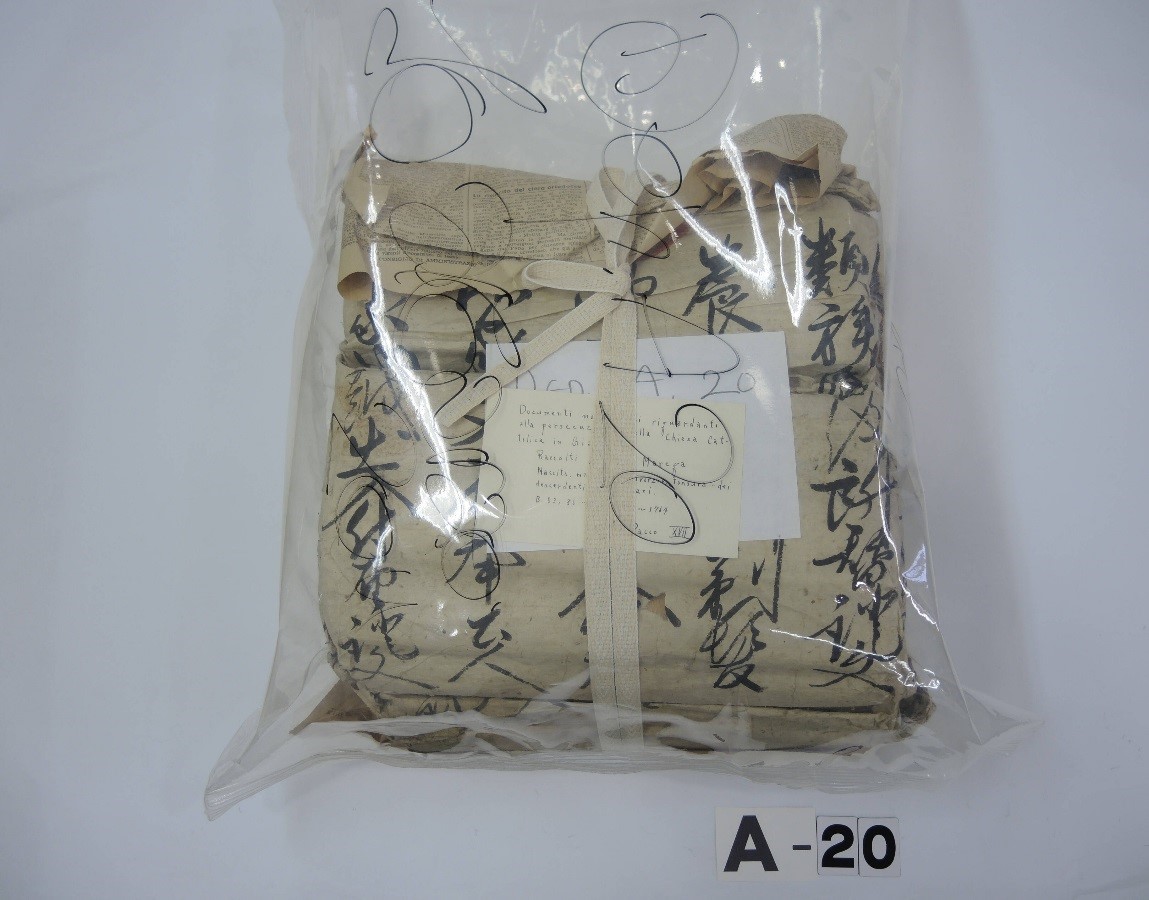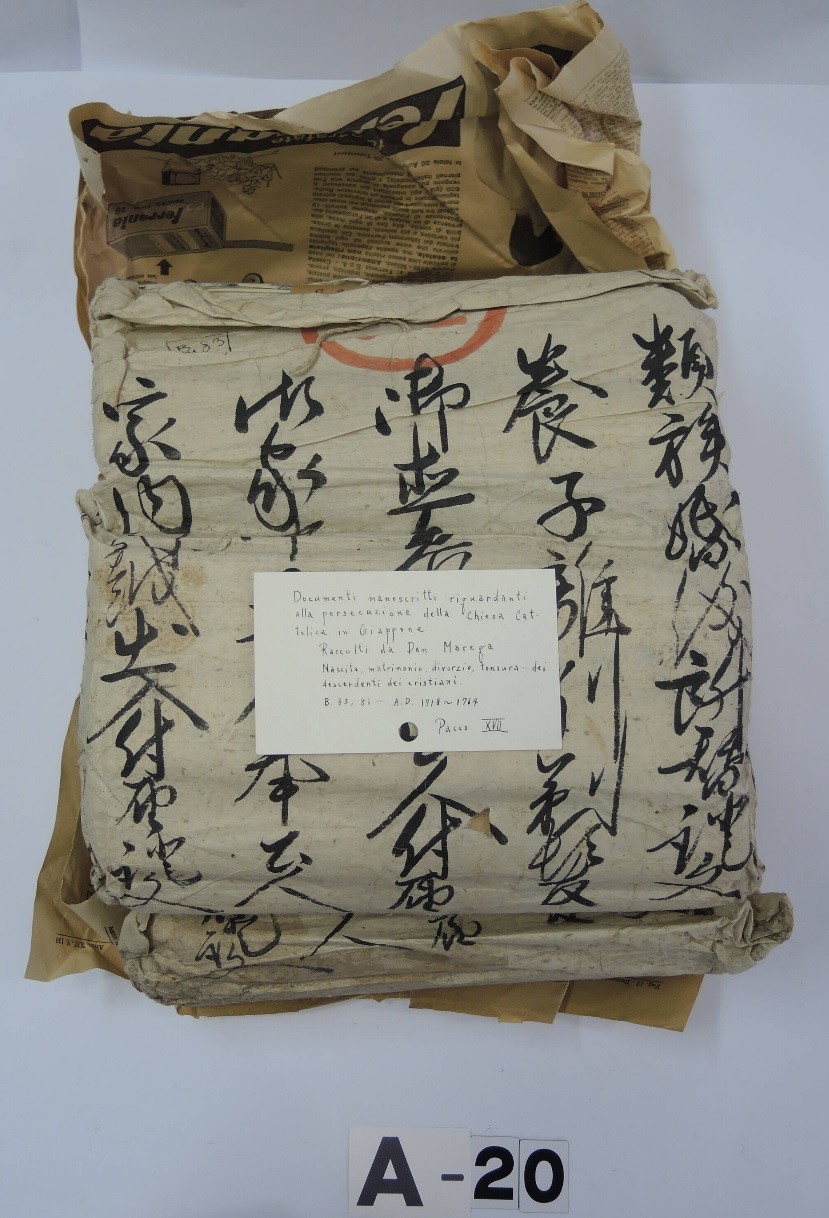- Reference Code
maregaA20
- Title
Fonds Marega File A20
- Date Range
- 1702–1789
- Primary Date Range
- Edo period
- Date Range Notes
- 1702 (Genroku 15) –1794 (Kansei 6)
- Description Level
File
- Quantity
- Record (1241 komonjo 古文書 / jō 状, 1 newspaper, 10 strings, 6 hōshi 包紙, 8 strips of paper, 24 koyori 紙縒)
- Notes on Physical State
-
A20 is comprised of two groups of documents (A20.02.01, A20.02.02) wrapped in newspaper (the Italian newspaper Il Tempo, 17 May 1959) and tied together with cotton preservation tape. A20.02.01 and A20.02.02 were each placed in bags. Written on each of the bags is the time period and documents contained therein. On A20.02.01, we find,
ruizoku kongi tokorogae shōmon 類族婚儀所替証文 [certificate regarding the marriages and moving of descendant(s) of Christians], gojikisan hōkōnin tsuketodoke 御直参奉公人付届 [notification regarding directly hired servant(s)], yōshi ribetsu teihatsu 養子離別剃髪 [notification regarding adoption, breaking of family ties, tonsure], gojikisan hōkōnin tsuketodoke, gokachū matawahōkōnin 御家中又者奉公人 [notification regarding vassal retainer(s) and servant(s)], and kanai hikkoshi deiiri tsuketodoke shōmon 家内引越出入付届証文 [notification regarding vassal[s] moving] spanning from the twenty-first day of the eleventh month of 1763 (Hōreki 13), the year of the goat, to the twentieth day of the sixth month of 1764 (Hōreki 14), year of the monkey. On A20.02.02, we find
ruizoku kongi tokorogae shōmon, yōshi ribetsu teihatsu, gojikisan hōkōnin tsuketodoke, gokachū mata wa hōkōnin, gokanai matawa hōkōnin, and kanai hikkoshi deiiri tsuketodoke shōmon from the twenty-first day of the eleventh month of Meiwa 1, the year of the monkey to [? damaged] Meiwa 2, the year of the rooster. - Provenance / Creation
- Father Mario Marega. The komonjo (archival documents) are originally from Usuki Domain’s Office of Religious Affairs (shūmonkata 宗門方).
- Place Name
- Ōita City and Usuki City, Ōita Prefecture, Himon’ya, Meguro City, Tōkyō-to
- Positions, etc
- Salesians of Don Bosco missionary.
- Archival History
- Donated to the Vatican Library by Mario Marega in 1953.
- Scope and Content
A20.02.01 is comprised of nine bundles. Each of them was wrapped with a paper band and then they were all tied together with twine. All are jō. On each of the bands is written the Marega Number “B83.” The years and number of items for each of the bundles are show in Table 1. There are a total of 585 items. The majority are from the Hōreki period (1751–1764).
Many relate to domain residents moving. While there are 190 notifications of residents moving for some reason, all adoption and marriage cases (144 and 56, respectively) involve moving in some way, and therefore can also be classified as moving notifications. There are also 44 requests for an extension of stay. Individuals who were staying in temples in Edo (Tokyo), Kyoto, or elsewhere to study would request that they be allowed to stay for longer periods of time. Many of the documents unrelated to moving involve tonsure notifications (39).
A20.02.02 is comprised of thirteen bundles. All consist of jō. These are not grouped by Marega numbers. A person took them out one by one from the top of a pile and assigned numbers to what they judged to be groups. The dates and number of items for each bundle are shown in Table 2. There are a total of 656 items. They are from before the Hōreki period (1751–1764), older than A20.02.01.
Almost all items are birth notifications (618). In addition to the names of the people born, their parishioner temples are also included. The notifications were sent by village or town headmen. Some include information of the birth family’s current state, such as siblings. For example, A20.02.01.01.04 (twenty-eighth day of 1746 (Enkyō 3), from Yamaoku Village Headman Shirōemon to Ōwaki Giemon and two others), we find the following: “Kadoroku, the great-great grandchild of Hase Village’s Kyūemon, one year old this year; this Kadoroku was born on the twenty-fifth day of the seventh month; they will be a parishioner of their father’s parishioner Shin sect temple Ryōninji, two older brothers have been reported but one has died from illness.” The person from which the baby is descended, this person’s village, as well as the sect and name of the baby’s parishioner temple are written. Such birth notifications will surely be very useful for analyzing villages in the Usuki Domain during the middle of the early modern period. However, the lack of female birth notifications is a cause for concern; almost all are for males and only 57 for females. Therefore, an analysis of why this is the case is also necessary.
- Languages Used
- Japanese (1241; approximate), Italian (2 catalogue entries: 1 newspaper, 1 memo)
- Date Description Written
- 2018/08/25
- Reference Images



